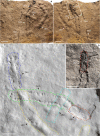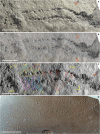Late Ediacaran trackways produced by bilaterian animals with paired appendages - PubMed (original) (raw)
Late Ediacaran trackways produced by bilaterian animals with paired appendages
Zhe Chen et al. Sci Adv. 2018.
Abstract
Ediacaran trace fossils provide key paleontological evidence for the evolution of early animals and their behaviors. Thus far, however, this fossil record has been limited to simple surface trails and relatively shallow burrows. We report possible trackways, preserved in association with burrows, from the terminal Ediacaran Shibantan Member (ca. 551 to ca. 541 million years ago) in the Yangtze Gorges area of South China. These trace fossils represent the earliest known trackways. They consist of two rows of imprints arranged in poorly organized series or repeated groups. These trackways may have been produced by bilaterian animals with paired appendages, although the phylum-level phylogenetic affinity of the trace makers remains unknown. It is possible that the trackways and associated burrows were produced by the same trace maker, indicating a complex behavior involving both walking and burrowing. Together, these trackways and burrows mark the arrival of a new era characterized by an increasing geobiological footprint of bilaterian animals.
Figures
Fig. 1. Geological map and stratigraphic column.
(A) Generalized geological map of the Yangtze Gorges area, showing the distribution of Ediacaran strata and the fossil location at Wuhe (triangle). Inset map shows the location of the Yangtze Platform in South China. (B) Stratigraphic column of the Ediacaran Doushantuo and Dengying formations, showing stratigraphic occurrences of fossils, including the trackways (triangle) reported in this paper. Mbr, Member; Fm, Formation; SSF, small shelly fossil; HMJ, Hamajing Formation. Zircon U-Pb ages from the work of Schmitz (40). Figure produced by S.X. using Adobe Illustrator.
Fig. 2. Trackways and burrows excavated in situ from the Shibantan Member.
(A and B) Epirelief (top bedding surface) and hyporelief (bottom bedding surface), respectively. NIGP-166148. Trackways (TW1 and TW2) and undermat burrows (UB1 to UB3) are labeled. (C) Latex mold of (B), with trackways and burrows marked and labeled. (D) Enlargement of rectangle in (B), showing connection between TW2 and UB3 (marked). All photographs were taken with lighting from upper right. Scale bars, 2 cm. Figure produced by Z.C. and S.X. using Adobe Photoshop.
Fig. 3. Trackway TW1 under different lighting directions.
(A to E) All are epireliefs. At least four sets of tracks [yellow lines in (E)] can be vaguely recognized, each consisting of two opposingly facing series that are at an acute angle to the midline. Discontinuous impressions along the midline and oblique scratches on the right side of the trackway are vaguely recognizable in (C) and (D), which are enlargements of top and bottom rectangles in (B), respectively. These faint structures are marked in green color in (E) to assist interpretation. The oblique scratches are marked by blue arrows in (C) and (D). Orange arrows identify lighting directions. Scale bars, 2 cm (A, B, and E); 1 cm (C and D). Figure produced by Z.C. and S.X. using Adobe Photoshop.
Fig. 4. Comparison between Shibantan and Paleozoic trackways.
(A to C) Epirelief trackway TW2 under different lighting directions. Repeated track groups (yellow lines) and repeated small shallow dimples (red circles) are marked. Labels L1 to L6 denote different imprints or tracks presumably made by different locomotive appendages of the animal. Orange arrows identify lighting directions. (D) Early Devonian trackway Danstairia congesta from the Old Red Sandstone in Scotland. Courtesy of L. Buatois. Scale bars, 2 cm. Figure produced by Z.C. and S.X. using Adobe Photoshop.
Fig. 5. Possible trackways associated with trace fossils of the genus Lamonte from the Shibantan Member.
(A) Positive hyporelief from the same bedding surface where trackways illustrated in Fig. 2 were found. Two species are recognized on the basis of size: L. trevallis (labeled as Lt) is narrower than Lamonte sp. (labeled as Ls). Note that Lamonte sp. consists of possible trackways (arrows; with poorly preserved imprints) transitioning into burrows (arrowheads). NIGP-166149 (catalog number for the entire slab). (B) L. trevallis from a different stratigraphic horizon of the Shibantan Member. Note burrows (arrowheads) and possible tracks (arrows) preserved as positive and negative epireliefs, respectively. Also illustrated in the study of Chen et al. (13). NIGP-154193. Figure produced by Z.C. and S.X. using Adobe Photoshop.
Similar articles
- Death march of a segmented and trilobate bilaterian elucidates early animal evolution.
Chen Z, Zhou C, Yuan X, Xiao S. Chen Z, et al. Nature. 2019 Sep;573(7774):412-415. doi: 10.1038/s41586-019-1522-7. Epub 2019 Sep 4. Nature. 2019. PMID: 31485079 - The origin of the animals and a 'Savannah' hypothesis for early bilaterian evolution.
Budd GE, Jensen S. Budd GE, et al. Biol Rev Camb Philos Soc. 2017 Feb;92(1):446-473. doi: 10.1111/brv.12239. Epub 2015 Nov 20. Biol Rev Camb Philos Soc. 2017. PMID: 26588818 Review. - Discovery of the oldest bilaterian from the Ediacaran of South Australia.
Evans SD, Hughes IV, Gehling JG, Droser ML. Evans SD, et al. Proc Natl Acad Sci U S A. 2020 Apr 7;117(14):7845-7850. doi: 10.1073/pnas.2001045117. Epub 2020 Mar 23. Proc Natl Acad Sci U S A. 2020. PMID: 32205432 Free PMC article. - Bilaterian burrows and grazing behavior at >585 million years ago.
Pecoits E, Konhauser KO, Aubet NR, Heaman LM, Veroslavsky G, Stern RA, Gingras MK. Pecoits E, et al. Science. 2012 Jun 29;336(6089):1693-6. doi: 10.1126/science.1216295. Science. 2012. PMID: 22745427 - The earliest fossil record of the animals and its significance.
Budd GE. Budd GE. Philos Trans R Soc Lond B Biol Sci. 2008 Apr 27;363(1496):1425-34. doi: 10.1098/rstb.2007.2232. Philos Trans R Soc Lond B Biol Sci. 2008. PMID: 18192192 Free PMC article. Review.
Cited by
- Ancestral morphology of Ecdysozoa constrained by an early Cambrian stem group ecdysozoan.
Howard RJ, Edgecombe GD, Shi X, Hou X, Ma X. Howard RJ, et al. BMC Evol Biol. 2020 Nov 23;20(1):156. doi: 10.1186/s12862-020-01720-6. BMC Evol Biol. 2020. PMID: 33228518 Free PMC article. - The rise and early evolution of animals: where do we stand from a trace-fossil perspective?
Mángano MG, Buatois LA. Mángano MG, et al. Interface Focus. 2020 Aug 6;10(4):20190103. doi: 10.1098/rsfs.2019.0103. Epub 2020 Jun 12. Interface Focus. 2020. PMID: 32642049 Free PMC article. Review. - A trace fossil made by a walking crayfish or crayfish-like arthropod from the Lower Jurassic Moenave Formation of southwestern Utah, USA.
Rose M, Harris JD, Milner ARC. Rose M, et al. PeerJ. 2021 Jan 26;9:e10640. doi: 10.7717/peerj.10640. eCollection 2021. PeerJ. 2021. PMID: 33569249 Free PMC article. - Himatiichnus mangano igen. et isp. nov., a scalidophoran trace fossil from the late Ediacaran of Namibia.
Turk KA, Pulsipher MA, Mocke H, Laflamme M, Darroch SAF. Turk KA, et al. R Soc Open Sci. 2024 Oct 16;11(10):240452. doi: 10.1098/rsos.240452. eCollection 2024 Oct. R Soc Open Sci. 2024. PMID: 39479238 Free PMC article. - Were the First Trace Fossils Really Burrows or Could They Have Been Made by Sediment-Displacive Chemosymbiotic Organisms?
McIlroy D. McIlroy D. Life (Basel). 2022 Jan 18;12(2):136. doi: 10.3390/life12020136. Life (Basel). 2022. PMID: 35207424 Free PMC article. Review.
References
- Erwin D. H., Laflamme M., Tweedt S. M., Sperling E. A., Pisani D., Peterson K. J., The Cambrian conundrum: Early divergence and later ecological success in the early history of animals. Science 334, 1091–1097 (2011). - PubMed
- Love G. D., Grosjean E., Stalvies C., Fike D. A., Grotzinger J. P., Bradley A. S., Kelly A. E., Bhatia M., Meredith W., Snape C. E., Bowring S. A., Condon D. J., Summons R. E., Fossil steroids record the appearance of Demospongiae during the Cryogenian period. Nature 457, 718–721 (2009). - PubMed
- Xiao S., Laflamme M., On the eve of animal radiation: Phylogeny, ecology and evolution of the Ediacara biota. Trends Ecol. Evol. 24, 31–40 (2009). - PubMed
- M. F. Glaessner, The Dawn of Animal Life: A Biohistorical Study (Cambridge Univ. Press, 1984), 244 pp.
- Parry L., Tanner A., Vinther J., The origin of annelids. Palaeontology 57, 1091–1103 (2014).
Publication types
MeSH terms
LinkOut - more resources
Full Text Sources
Other Literature Sources




